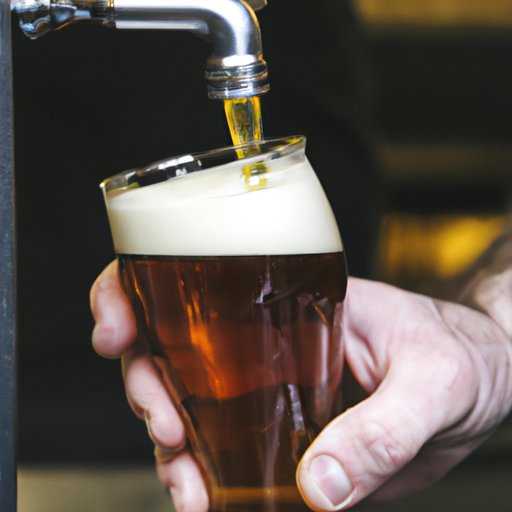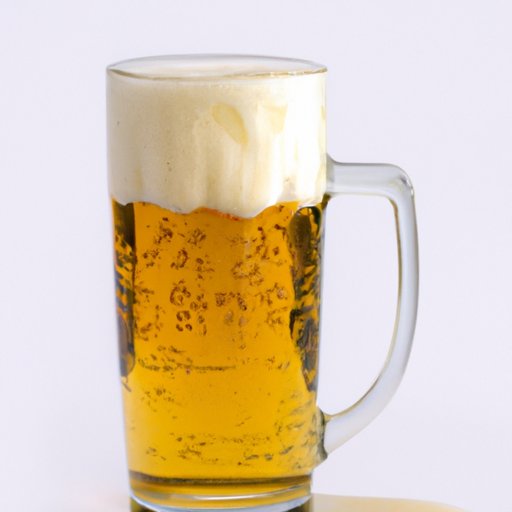A Comprehensive Guide to Understanding What a Pint Is
When it comes to beer, understanding what a pint is can be more complicated than you might think. The term is used frequently, but the actual definition of a pint isn’t always clear. If you’re a beer drinker who wants to understand more about the measurement and volume of a pint, this comprehensive guide will take you through the basics and provide you with some interesting historical and cultural context.
Define What a Pint Is in Terms of Measurement and Volume
A pint is a unit of measurement used to describe volume. In the United States, a pint is equivalent to 16 fluid ounces, or about 473 milliliters. In the United Kingdom and other parts of the world, a pint is equivalent to 20 fluid ounces, or about 568 milliliters.
When it comes to beer, it’s important to note that a pint doesn’t necessarily refer to the size of the glass in which it’s served. In fact, many bars and restaurants use glasses that are larger or smaller than a true pint glass.
If you’re in the US, you’ll often see pints served in glasses that hold 20 ounces or more. These are often referred to as “imperial” pints, and they’re larger than the traditional 16-ounce American pint. In places like the UK, a half-pint is a popular measurement, and a pint is still the most popular serving size of beer.
Why a Pint Is a Common Unit of Measurement for Beer
While pints have been used as a unit of measurement for centuries, they’re particularly prevalent in the world of beer. There are a few reasons for this.
One of the primary reasons is tradition. Beer has been brewed and consumed for thousands of years, and throughout that time, pints have been a common unit of measurement for liquid. When beer became a commercial product, it made sense to keep the pint as a standard measurement.
Another reason for the popularity of the pint is simply that it’s a convenient size. It’s a larger serving than a half-pint, but not so large that it becomes unwieldy or difficult to drink. For many beer drinkers, a pint is the perfect amount to enjoy with friends or over the course of an evening.
The Evolution of the Pint: A Historical Perspective
The pint has been a common unit of measurement for centuries, but its origins are somewhat murky. The word itself derives from the Old French word “pinte,” which means “liquid measure.”
Throughout history, different cultures have used pints as a standard unit of measurement. In the United Kingdom, the pint has been a standard measurement since the 14th century. In the US, the pint was established as a standard unit of measurement in the late 19th century.
Over time, the size and shape of the pint have evolved. In some parts of the world, pints refer to larger volumes than they do in others. In addition, different styles of pint glasses have emerged over time, from the traditional British pint glass with a “handle” to the sleek, modern nonic pint glass.
Pint: What It Means in Different Parts of the World
While the pint is a recognizable unit of measurement around the world, its precise meaning can vary depending on where you are.
In the UK, a pint refers to a volume of 20 fluid ounces, and it’s the standard unit of measurement for beer. In Ireland, the pint is an important part of the cultural and social fabric, particularly when it comes to pints of Guinness.
In Australia, the pint is also a popular measurement for beer, but it refers to a smaller volume than in the UK. A pint in Australia is 16.9 fluid ounces, which is closer to the US pint than the UK pint.
In the US, the pint is a standard unit of measurement for beer in many states, but it can vary depending on local laws. Some states allow bars and restaurants to serve pints that are larger than 16 ounces, while others require strict adherence to the standard.
Exploring the Different Types of Pints and How They Are Used
While a pint is a specific volume of liquid, there are many different types of pint glasses that can be used to serve beer. Each style of glass has its own unique shape and purpose. Here are a few of the most common types:
- Conical pint: This glass is shaped like an inverted cone, and it’s widely used in the UK. It’s particularly popular for serving ales and stouts.
- Nonic pint: This glass has a slight bulge near the top, which helps prevent the glass from slipping out of your hand. It’s a popular style in many countries.
- Tulip pint: This glass has a flared top that resembles a tulip flower. It’s often used for serving Belgian ales and other styles of beer that benefit from a wider opening.
The shape of the pint glass can affect the drinking experience in a number of ways. Some glasses are designed to showcase the beer’s color and aroma, while others may be better for head retention or carbonation.
Why Is a Pint Such a Common Unit of Measurement for Beer?
Beer and pints go together like peanut butter and jelly, but why exactly is a pint the go-to serving size for beer?
For one thing, pints are a convenient size. They’re large enough to feel substantial, but not so large that they become difficult to manage. In addition, a pint typically costs less than ordering two smaller beers, making it a cost-effective option for many people.
Finally, the pint has become something of a cultural icon when it comes to beer. The simple act of sharing a pint with friends can be a bonding experience, and the communal nature of drinking from a shared vessel has been a tradition for centuries.
The Debate on Whether a Pint is More Than Just a Glass Size
For many beer drinkers, a pint is more than just a volume of liquid. It’s a symbol of friendship, camaraderie, and socializing.
There’s something special about sharing a pint with friends or family, and the act of drinking from the same glass can create a sense of connection and community. In some cultures, such as in Ireland, the pint has a deep symbolic significance beyond just its size as a serving vessel.
Of course, not everyone feels this way. Some beer drinkers see the pint purely as a container for liquid, and they’re happy to drink beer in any style of glass or container.

How to Pour the Perfect Pint Every Time
If you’re a beer lover, you know that there’s an art to pouring the perfect pint. Here are some tips for getting it just right:
- Start with a clean glass: Make sure your pint glass is absolutely clean and free of any residue or soap scum.
- Tilt the glass: Hold the glass at a 45-degree angle and tilt it toward the tap as you pour.
- Pour slowly: Allow the beer to flow gently down the side of the glass, gradually straightening the glass as you go.
- Create a head: When you reach the top of the glass, tilt it back slightly and allow the beer to flow more quickly, creating a head on top of the beer.
- Serve immediately: Once you’ve poured your pint, serve it immediately to maximize the flavor and aroma.
Conclusion
Understanding what a pint is may seem like a simple matter, but as this guide has shown, there’s actually quite a bit to consider. From the historical origins of the pint to the cultural significance of the serving size, pints are an important part of the world of beer. Whether you’re a casual beer drinker or a die-hard enthusiast, knowing more about pints can help you appreciate beer in new ways.
